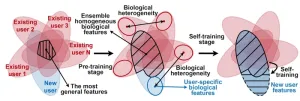(Press-News.org) LA JOLLA, CA—A population of unconventional white blood cells has recently captured the attention of immunologists and clinicians alike. Unlike conventional T cells, which circulate throughout the body in our blood, mucosal-associated invariant T (MAIT) cells are largely found in tissues where they provide immune protection against a broad range of diseases.
MAIT cells are highly abundant in humans. Although they make up only 2 percent of the lymphocytes in blood, MAIT cells account for 10 to 40 percent of lymphocytes in the liver, and they are common in tissues such as lungs. Still, much about MAIT cell biology and clinical function remains unknown.
In a new study, published in Nature Cell Biology, scientists at La Jolla Institute for Immunology (LJI) explored the location, function, gene expression, and metabolism of MAIT cells in the mouse lung.
“Metabolism is the way your cells use fuel molecules to do their work,” says LJI Instructor Thomas Riffelmacher, Ph.D., first author of the study. “There’s been a recent revolution in the field in which studies are starting to link the function of T cells to their metabolic programming, but this had not yet been explored in MAIT cells.”
To pioneer this line of research, Riffelmacher teamed up with LJI Professor and Chief Scientific Officer Mitchell Kronenberg, Ph.D., an expert on innate-like T cells that make more rapid responses. Their latest work characterizes these properties in MAIT cells and how they contribute to the population’s ability to fight off pathogens.
The efforts revealed two distinct “flavors” of MAIT cells: an antiviral subtype fueled by sugar and an antibacterial subtype fueled by fat. The findings may now inspire novel vaccines and cell therapies that shift the balance between these two cell groups to help individuals fight specific pathogens.
A tale of two cell types
MAIT cells exhibit enhanced memory-like responses after some infections, with higher cell numbers and stronger protective responses boosting the host’s defenses long after the pathogen has left the body. Riffelmacher initially set out to explore what molecular changes drove this important memory function in MAIT cells.
To do this, he delivered a live bacterial vaccine strain to a mouse model, and within days, MAIT cells had expanded 100-fold in the animals’ lungs. What Riffelmacher didn’t expect to see was the emergence of two different groups of cells within this expanded population. Through a comprehensive set of experiments to characterize these two cell lineages, several distinct properties became clear.
One subtype of MAIT cells, predominantly located along blood vessels in the lung, produced a type 1 immune response defined by the secretion of a cytokine called interferon-gamma (IFN-ɣ). These lymphocytes, called MAIT1 cells, were specialized to fight intracellular microbes, namely viruses like influenza.
The other subtype of MAIT cells, predominantly found in lung tissue, produced a type 17 immune response defined by the secretion of a different cytokine, interleukin-17 (IL-17). MAIT17s were specialized to fight extracellular microbes, namely bacteria like those that lead to pneumonia.
To further demonstrate their distinct protective properties, the researchers purified MAIT1 and MAIT17 cells and transferred them into new mice. Both populations enhanced the animals’ immunity compared with untreated mice. However, MAIT1s provided better protection against the influenza virus, while MAIT17s protected against the bacteria Streptococcus pneumoniae, the most common cause of pneumonia.
Still more striking than their functional differences were their highly divergent metabolic programs. Each cell type appeared to get its energy from a different source.
“I remember seeing this first batch of data and thinking, ‘Wow, this is a huge difference—we need to look into this,’” says Riffelmacher, who also serves as the LJI Immunometabolism Core Director.
MAIT1s remained in a very low-energy, dormant state until activated, at which point they relied on sugar (glycolysis) to get their fuel. MAIT17s, on the other hand, were highly active and required constant consumption of fatty acids to generate enough energy through their mitochondria. When the researchers genetically manipulated white blood cell metabolism to favor glycolysis, MAIT1 cell numbers were elevated, confirming that metabolism influenced the MAIT cell response.
What’s the (clinical) use?
Does this mean eating fatty foods could protect you against pneumonia? Kronenberg says diet can have some influence on the distribution of metabolites in the body, but metabolism functions differently at the cellular and organismal levels, so there’s no proof that changing one’s eating patterns would influence MAIT cell function.
Still, by tweaking the levels of these metabolites pharmacologically, the researchers were actually able to shift the animals’ MAIT cell response likely to be better at fighting either a viral infection or bacteria.
To do this clinically in humans, the researchers suggest developing vaccines to activate either MAIT1 or MAIT17 cells, or even transplanting one cell subtype into patients to boost a particular immune response. Because MAIT cells and the main signaling protein they interact with are so highly conserved across individuals and species, they are also much less likely to trigger a graft-versus-host response than other types of white blood cells.
“Our hope is that in the future, we’ll have tools to selectively enhance MAIT1s or MAIT17s so that patients can have their immune systems tuned against different pathogens as necessary,” says Kronenberg.
Additional authors of the study, “Divergent metabolic programs control two populations of MAIT cells that protect the lung,” include Mallory Paynich Murray, Chantal Wientjens, Shilpi Chandra, Viankail C. Castelan, Ting-Fang Chou, Sara McArdle, Christopher Dillingham, Jordan Devereaux, Aaron Nilsen, Simon Brunel, David Lewinsohn, Jeff Hasty, Gregory Seumois, Christopher Benedict, and Pandurangan Vijayanand.
This research was supported by the National Institutes of Health (NIH; grants AI71922, AI137230), and the Wellcome Trust (grant 210842_Z_18_Z).
###
About La Jolla Institute
The La Jolla Institute for Immunology is dedicated to understanding the intricacies and power of the immune system so that we may apply that knowledge to promote human health and prevent a wide range of diseases. Since its founding in 1988 as an independent, nonprofit research organization, the Institute has made numerous advances leading toward its goal: life without disease. Visit lji.org for more information.
END
Can sugar and fat influence immune cell responses?
LJI scientists find MAIT cells can be tuned to fight different pathogens via their metabolism, paving the way for new therapeutic strategies
2023-05-25
ELSE PRESS RELEASES FROM THIS DATE:
County-level maternal vulnerability and preterm birth
2023-05-25
About The Study: The findings of this study using data for 3.6 million births suggest that the Maternal Vulnerability Index (MVI), a novel county-level index designed to quantify maternal vulnerability to adverse health outcomes, was associated with preterm birth even after adjustment for individual-level confounders. The MVI is a useful measure for county-level preterm birth risk that may have policy implications for counties working to lower preterm rates and improve perinatal outcomes.
Authors: Sara C. Handley, M.D., M.S.C.E., Children’s Hospital of Philadelphia, is the corresponding author.
To ...
Deep learning for detection and symptom severity assessment of autism spectrum disorder
2023-05-25
About The Study: In this diagnostic study of 45 children with autism spectrum disorder (ASD) and 50 with typical development, a deep learning system trained on videos acquired using a joint attention–eliciting protocol for classifying ASD versus typical development and predicting ASD symptom severity showed high predictive performance. This new artificial intelligence–assisted approach based predictions on participants’ behavioral responses triggered by social cues. The findings suggest that this method may allow digital measurement of joint attention; however, follow-up studies are necessary for further validation.
Authors: Yu ...
Using AI, scientists find a drug that could combat drug-resistant infections
2023-05-25
CAMBRIDGE, MA -- Using an artificial intelligence algorithm, researchers at MIT and McMaster University have identified a new antibiotic that can kill a type of bacteria that is responsible for many drug-resistant infections.
If developed for use in patients, the drug could help to combat Acinetobacter baumannii, a species of bacteria that is often found in hospitals and can lead to pneumonia, meningitis, and other serious infections. The microbe is also a leading cause of infections in wounded soldiers in Iraq and Afghanistan.
“Acinetobacter can survive on hospital doorknobs and equipment ...
Monkey model offers clues for potential widespread HIV cure in people
2023-05-25
PORTLAND, Oregon -- New animal research is helping explain why at least five people have become HIV-free after receiving a stem cell transplant. The study’s insights may bring scientists closer to developing what they hope will become a widespread cure for the virus that causes AIDS, which has infected about 38 million people worldwide.
Published in the journal Immunity, the Oregon Health & Science University-led study describes how two nonhuman primates were cured of the monkey form of HIV after receiving a stem cell transplant. ...
OU professor leading research for next steps in monitoring bat coronaviruses
2023-05-25
Since the emergence of SARS in 2002, coronaviruses have been recognized as potential pandemic threats. This emergence highlights a need for evidence-based strategies to monitor bat coronaviruses. Daniel Becker, Ph.D., a researcher at the University of Oklahoma, is collaborating with other scientists nationwide to determine directions for future research.
Becker, an OU assistant professor of biology, was the senior author of a paper published in Nature Microbiology. The study’s lead author was Lily Cohen, a medical student at the Icahn ...
New framework for defining long COVID highlights twelve signature symptoms
2023-05-25
Long COVID, or Post-Acute Sequelae of SARS-CoV-2 infection (PASC), includes a wide range of symptoms that present or persist more than 30 days after COVID-19 infection. With over 650 million people globally having been infected with SARS-CoV-2, long COVID represents a significant public health concern that affects quality of life, earnings, and health care costs. To better understand the prevalence and severity of symptoms, the National Institutes of Health (NIH) launched Researching COVID to Enhance Recovery (RECOVER-Adult), ...
Development of a definition of Long COVID
2023-05-25
About The Study: In this analysis of data from 9,764 participants in the RECOVER adult cohort, a prospective longitudinal cohort study, 37 symptoms across multiple pathophysiological domains were identified as present more often in SARS-CoV-2–infected participants at six months or more after infection compared with uninfected participants. A preliminary rule for identifying postacute sequelae of SARS-CoV-2 infection (PASC), also known as long COVID, was derived based on a composite symptom score. As a first step to providing a framework for other investigations, iterative refinement that further incorporates other clinical features is needed ...
Identifying the gut bacteria that threaten neonatal babies
2023-05-25
Researchers from the Quadram Institute and University of East Anglia have identified what makes some strains of gut bacteria life-threatening in pre-term babies.
The findings will help identify and track dangerous strains and protect vulnerable neonatal babies.
A major threat to neonatal babies with extremely low birth weight is necrotising enterocolitis (NEC).
Rare in full term babies, this microbial infection exploits vulnerabilities destroying gut tissue leading to severe complications. Two out of five cases are fatal.
One bacterial species that causes especially sudden and severe disease is Clostridium perfringens. These ...
CityU researchers develop a self-supervised AI adaptation framework to enhance sensing accuracy of EMG devices
2023-05-25
Surface electromyography (EMG) has been widely used to measure the electrical activity of muscles. However, the variability in EMG sensing signals due to biological differences of different users significantly degrades the performance and potential of EMG systems. Recently, researchers from City University of Hong Kong (CityU) developed a deep learning-based framework called EMGSense, which can achieve high sensing performance for new users using AI self-training techniques. This opens a new path for developing more advanced and accurate wearable EMG devices in areas like neurorehabilitation and virtual reality.
This ...
Insilico Medicine receives IND approval for novel AI-designed USP1 inhibitor for cancer
2023-05-25
Insilico Medicine (“Insilico”), a generative artificial intelligence (AI)-driven clinical stage drug discovery company, today announced that the U.S. Food and Drug Administration (FDA) recently approved the initial investigational new drug (IND) application for ISM3091 for the treatment of patients with solid tumors. This is Insilico's first oncology program to advance to the clinical validation stage.
The open-label, multicenter Phase I clinical trial of ISM3091 will be conducted simultaneously in the U.S. and China ...
LAST 30 PRESS RELEASES:
Why nail-biting, procrastination and other self-sabotaging behaviors are rooted in survival instincts
Regional variations in mechanical properties of porcine leptomeninges
Artificial empathy in therapy and healthcare: advancements in interpersonal interaction technologies
Why some brains switch gears more efficiently than others
UVA’s Jundong Li wins ICDM’S 2025 Tao Li Award for data mining, machine learning
UVA’s low-power, high-performance computer power player Mircea Stan earns National Academy of Inventors fellowship
Not playing by the rules: USU researcher explores filamentous algae dynamics in rivers
Do our body clocks influence our risk of dementia?
Anthropologists offer new evidence of bipedalism in long-debated fossil discovery
Safer receipt paper from wood
Dosage-sensitive genes suggest no whole-genome duplications in ancestral angiosperm
First ancient human herpesvirus genomes document their deep history with humans
Why Some Bacteria Survive Antibiotics and How to Stop Them - New study reveals that bacteria can survive antibiotic treatment through two fundamentally different “shutdown modes”
UCLA study links scar healing to dangerous placenta condition
CHANGE-seq-BE finds off-target changes in the genome from base editors
The Journal of Nuclear Medicine Ahead-of-Print Tip Sheet: January 2, 2026
Delayed or absent first dose of measles, mumps, and rubella vaccination
Trends in US preterm birth rates by household income and race and ethnicity
Study identifies potential biomarker linked to progression and brain inflammation in multiple sclerosis
Many mothers in Norway do not show up for postnatal check-ups
Researchers want to find out why quick clay is so unstable
Superradiant spins show teamwork at the quantum scale
Cleveland Clinic Research links tumor bacteria to immunotherapy resistance in head and neck cancer
First Editorial of 2026: Resisting AI slop
Joint ground- and space-based observations reveal Saturn-mass rogue planet
Inheritable genetic variant offers protection against blood cancer risk and progression
Pigs settled Pacific islands alongside early human voyagers
A Coral reef’s daily pulse reshapes microbes in surrounding waters
EAST Tokamak experiments exceed plasma density limit, offering new approach to fusion ignition
Groundbreaking discovery reveals Africa’s oldest cremation pyre and complex ritual practices
[Press-News.org] Can sugar and fat influence immune cell responses?LJI scientists find MAIT cells can be tuned to fight different pathogens via their metabolism, paving the way for new therapeutic strategies





